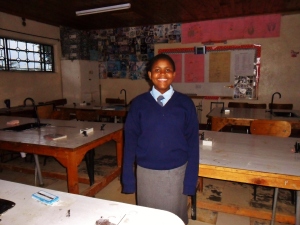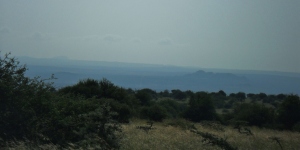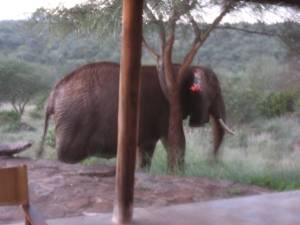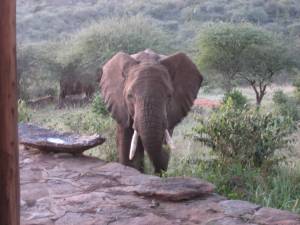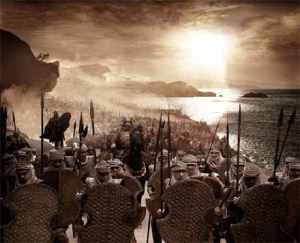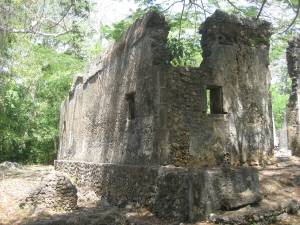The Amazing Race
Air Date: March 29th, 2010
Location: Nairobi, Kenya
Primary Goal: In one day, obtain 1 year residence visa and return to Nanyuki town
Toughest Opponents: Time and Nairobi chaos
In City Centre, the traffic already roaring outside, the sun rays penetrated the cracks of the Terminal Hotel room curtains. It was 7:35 and Team Mpala blinked the sleep from their eyes. The instructions before them were stated simply enough: Go to Nyayo House, the Kenyan immigration centre, and acquire essential documents for a one year residence visa.
The team of Mpala friends Stephanie and Allison made a crucial decision to stop at the popular coffee joint Java House located across the street from their hotel for a caffeine charge. They would not have made it through the day without their cup of kahawa. Over coffee they strategized how to go about accomplishing the first step of the challenge. Before going to Immigration, the duo needed to collect a signed letter of approval for their visa from the National Museum located on the other side of town. It was the key to the Immigration Office. On a Monday morning at 9 a.m. traffic was at its worst – bumper to bumper covering every inch of pavement, stagnant exhaust fumes drenching the air was exacerbated by the already sweltering heat. Making another critical decision, they decided the most time-efficient method would be on foot.
They had been instructed to meet a Museum employee who worked with Mpala. He would have the signed letter and instructions for the next step in their journey. The trek to the Museum was no walk in the park. Pedestrian masses threatened to hinder their traveling speed and blurs of matatus and city buses whooshed by on the main roads making road crossing hazardous. On the way, Allison repeatedly tried to get in touch with their Museum contact. “I can’t reach him. It just keeps ringing with no answer,” Allison worriedly reported to Stephanie.
Having reached the Museum and still no word from their contact, the duo decided to locate his office, hoping he would be there. However, locating his office would be a challenge: the bowels of the Museum were made up of hundreds of offices and labs, hallways, entrances and exits twisting and turning on multiple levels – searching for the office was a potential time black hole. “Excuse me, we’re looking for the Mammology department. Can you help us find it?” Stephanie hurriedly asked one of the Museum guards when no museum maps were found. Giving the team a blank stare, the guard went looking for somebody who did know. Luckily for them, the guard returned several minutes later with a museum rep who led Team Mpala to the Mammology department. Knocking and then slowly opening their contact’s office door they were greeted with silence – the room was empty. Time check: 11:30.
After numerous frantic phone calls, Team Mpala finally reached their contact. He had been in a meeting and would be arriving at the Museum in twenty minutes. Twenty minutes came and went. Stephanie and Allison paced the office like caged lions constantly checking their watches. If they did not have the signed letter in their hands by the lunch hour, the race against time would most likely be lost. There was only a slim chance of getting through Immigration in an afternoon. However, as their hopes (and patience) almost ran out, their contact briskly walked through the door. With the signed paper now in their possession, they were instructed to proceed to the 5th floor, room 20 of Immigration where they would receive their next set of instructions. However, the team would have to make one more stop before heading to Nyayo House – not having enough cash on them, they needed to locate an atm in City Centre and withdraw enough to cover the visa fee.
Without looking back, Team Mpala raced through the maze of hallways and emerged into the blinding and sweltering afternoon sun. On foot again (even at noon the traffic was at a standstill), they maneuvered back to the chaos of City Centre and looked for an ATM. Seeing one a block ahead, they sprinted to the bank and each withdrew the required payment. At this point, the hands on the clock reached one… the nationwide lunch hour had arrived. All around them, people were filing into restaurants and bars for their midday reprieve. The team was stuck for an hour while all government buildings shut down. Making a smart decision to energize, Stephanie and Allison made their way to a large Nakumatt market chain store and ate lunch in the food court. At around quarter to two, they were refreshed and eager to get going – they abruptly got up and hit the pavement. “If we get there early, maybe we can get in the building and wait right outside the office door,” strategized Stephanie. “Good idea – beat the crowds,” answered Allison.
If only it was that easy…
Making their way to the mango-orange colored highrise building, Team Mpala turned a corner only to smack into a large crowd assembled in front of the Immigration office entrance. They weren’t the only ones with the “early bird gets the worm” idea. Ten minutes slowly crawled by and suddenly a shift in the crowd signaled the doors had been open. As a part of the mass, Stephanie and Allison made their way into the building. They scanned the large lobby for an elevator or stairs to the fifth floor. Not seeing anything but rows of barred windows where people were lining up to get passports stamped and papers signed, they asked an employee who informed them they were in the wrong part of the building. They needed to enter on the other side for access to the fifth floor – awesome. Time wasted: 20 minutes.
Sweat marks were now apparent on the backs of their shirts as they sprinted around the building to the main entrance. Rushing into the lobby with their eyes strained straight ahead searching for an elevator they suddenly heard, “Hey, you! Stop!” They had been waved down by the entrance security. Exasperated, Allison asked, “What’s the problem?!” The guards pointed to the team’s backpacks. Leaving their bags behind at the security desk, the team with passports and the letter in hand, tore away from the counter and punched the nearest elevator’s button. Their eyes swept across the numbered buttons on the inside wall: floor G, floor 11, floor 9, floor 6… floor 5 was not there. They threw their arms out before the doors shut and squeezed their way out of the crowded metal box. They checked three other elevators, furiously pushing their way through the crowds, only to find that none of the elevators went to the 5th floor. The team was losing valuable time. Why the elevators only went to the sixth floor and up was a mystery to the team and remains to be discussed. Perhaps a funny Immigration prank.
Deciding not to ask for an elevator that went to the fifth floor, they turned their focus to the stairs. They dashed up five flights and finally reached the Immigration Office. They dodged two more massive waiting crowds and located room 20. Breathing sighs of relief, they handed over the signed letter. They let their minds and bodies relax… big mistake. No more than a minute later they were instructed to return to the other side of the building to get a receipt and then return to floor 5, room 20. With adrenaline suddenly pumping through their systems, Stephanie and Allison checked their watches, glanced at each other and took off. There was no time to think about the ridiculousness of the whole situation – there was only time to continue moving ahead.
Would they make it?! Time seemed to be going by twice as fast and the offices shut down at 4:30…
Momentum on their side as they jumped every other step downstairs, they quickly sprinted around the sidewalks outside and reached the cashier counter. They caught their breath while their documents were looked over, stamped and signed. With the golden receipts in hand, they turned once again and headed back. Flashes of “suicides” crossed Allison’s mind, incredibly similar to conditioning days from past soccer training sessions. Just barely missing a head-on collision with someone on the stairs (probably trying to complete the same visa process) Stephanie and Allison arrived back at room 20. The Immigration officer looked over their paperwork and told them to take a seat outside in the waiting room for a few minutes (italics added by show producer) while she wrote up the visas. Smiling and exhausted, the team crumpled into the chairs, thinking they were almost at the finish line.
Two hours went by without any sign of movement from room 20. Yep. Two Hours. Frustrations and tempers were in overdrive. Stephanie and Allison would be lucky to make it to the matatu stage by 5 to catch a ride back to Nanyuki. Otherwise… they would have to remain in Nairobi for another night. Last place in the Amazing Race, if you will. Miraculously at 4:30 the woman emerged from room 20 and told the team to follow her. More stamping and signing of papers ensued and they were instructed to, once again, return to the other side of the building where they would get the final stamp of approval in their passports. Apparently that special stamp is only located in one window on the other side of the building – classic. Advantageously with the later hour, the crowds had significantly diminished and Stephanie and Allison had no problem making their way to the other entrance. Someone was there to meet them at the door (it was after business hours and the government employees had taken pity on them – bonus points). Closely following their host, they made their way to yet another large barred window and in a matter of seconds their passports were stamped. Legal residence for one year was obtained. However, this was no time to rejoice; they needed to make their way across town and leave in a matatu by 5:30 to ensure their journey would end in Nanyuki that evening. It was 5:10 – as long as nothing extreme got in their way… they would make it.
Making good use of their time, they weaved their way down side streets, even stopping for a cup of coffee to go, and reached the matatu stage in ten minutes. They pulled away from the stage 5 minutes later and suddenly, as if there was an earthquake in the sky, lightning cracks split the stormy clouds, thunder erupted and vibrated all around them and a torrent of rain descended upon the infamous Nairobi traffic. Seated in the back of the matatu, Stephanie and Allison peered through the rain streaked windows trying to make out their progress. With the rain pounding and horns blaring all around, they realized, as if punched in the gut, that they weren’t moving. By the looks of it, they wouldn’t be moving for some time. They had completely underestimated the rush hour traffic jam out of the city but, it was out of their control at this point – Team Mpala could only sit back and hope that they make it out of Nairobi before dark… darkness, rain and city driving were not a safe combination.
Both team members were rocked back and forth by the stop-and-go rhythm of the jam. Nausea overtook Stephanie and she did her best to keep the day’s lunch down. One and a half hours later, the worst of the storm had passed along with the traffic. By 7, they were cruising smoothly along the damp pavement. However, neither Stephanie or Allison was ready to relax yet. As if trying to calm their nerves, night arrived and the full moon rose majestically in the dark sky casting a gentle opaque light across the fields of maize and scattered acacia trees. A cool breeze constantly played across the passengers’ faces and they drifted off to sleep. They were jolted awake by the harsh braking of the matatu. Thinking the worst, they snapped up and looked around. It was 9 p.m. and they had arrived in Nanyuki. Drowsily climbing out of the matatu, they walked to a nearby hotel, booked a room for the night and passed out. They had done it – with a ride set up for the next morning back to Mpala they were home free.
No large cash prize or destination trip awarded to the winners was necessary… the Race was over and they had succeeded. Team Mpala can remain in Kenya to see another sunrise.
Next post… did someone say marathon?


